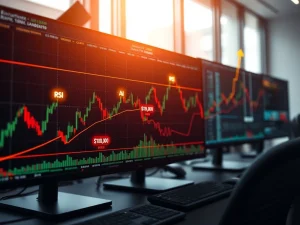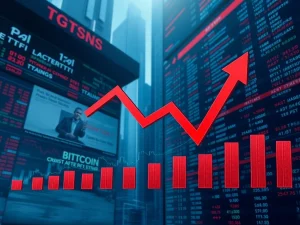Asian Shares Brace for Impact: Navigating Alarming Trade Tensions and Fed Policy Uncertainty

In a world increasingly interconnected, the tremors felt in traditional financial markets often send ripples through the burgeoning cryptocurrency space. As Asian shares experienced a notable retreat, driven by a cocktail of geopolitical anxieties and central bank anticipation, it begs the question: how does this volatility in conventional assets influence the digital frontier? For crypto enthusiasts, understanding these macro shifts is crucial, as they can directly impact investor sentiment, capital flows, and the perception of digital assets as safe havens or riskier plays.
The Unsettling Shadow of Trade Tensions
The latest market downturn across Asia underscores the pervasive fear surrounding escalating global trade tensions. Major indices like Japan’s Nikkei 225 and China Hong Kong’s Hang Seng Index both registered a 0.5% drop, signaling a palpable caution among investors. This retreat came despite a temporary resolution in Japan’s trade agreement with the U.S., highlighting that the broader U.S.-China trade dispute remains the elephant in the room. The impending August 1 tariff deadline set by U.S. President Donald Trump casts a long shadow, threatening to disrupt global supply chains and dampen economic growth.
- Impact on Exports: Countries heavily reliant on exports to the U.S. and China face significant headwinds.
- Supply Chain Disruption: Businesses are forced to reconsider sourcing and manufacturing strategies, leading to inefficiencies.
- Investor Uncertainty: The unpredictable nature of trade negotiations makes long-term investment decisions challenging.
Historically, periods of heightened trade conflict have led to a flight to safety, often benefiting traditional safe-haven assets. However, the unique dynamics of the current economic landscape suggest that digital assets might also play an evolving role as investors seek alternatives outside traditional governmental control.
Decoding the Federal Reserve’s Policy Path
Another significant factor weighing heavily on global markets is the uncertainty surrounding the Federal Reserve’s monetary policy. Strong U.S. jobs data has fueled expectations of a hawkish Fed posture, potentially delaying or reducing anticipated rate cuts. This outlook directly impacts borrowing costs, corporate earnings, and overall economic growth projections.
The market is keenly awaiting the Fed’s rate decision, which will be pivotal in shaping near-term market direction. President Trump’s recent public pressure on Chair Jerome Powell to lower borrowing costs adds another layer of complexity to an already delicate situation. Here’s why Fed policy is so critical:
| Policy Action | Potential Market Impact | Relevance for Crypto |
|---|---|---|
| Interest Rate Hike | Increases borrowing costs, potentially slowing economic growth; strengthens dollar. | Could make traditional investments more attractive, potentially reducing appetite for riskier assets like crypto. |
| Interest Rate Cut | Lowers borrowing costs, stimulates economic activity; weakens dollar. | Could encourage investment in riskier assets, including cryptocurrencies, as yield on traditional assets decreases. |
| Quantitative Tightening | Reduces money supply, tightens credit conditions. | Generally negative for all risk assets, including crypto, as liquidity shrinks. |
The interplay between Fed policy and market sentiment creates a volatile environment, prompting investors to reassess their portfolios and consider diversification strategies.
The Ascent of Dollar Strength Amidst Uncertainty
Amidst the widespread uncertainty, the U.S. dollar strength has become a prominent feature. The U.S. Dollar Index (DXY) climbed to near 97.55 in the Asian session, underscoring a significant shift in risk appetite. This ascent is driven by a combination of macroeconomic fundamentals, such as robust U.S. jobs data, and a classic flight to safety as investors seek refuge from trade war anxieties and domestic earnings pressures in Asian markets.
Conversely, the Japanese yen, typically a proxy for risk-off sentiment, has underperformed, with USD/JPY inching toward 147.37. This reflects Japan’s continued accommodative monetary policy stance and domestic political developments. The euro also closed lower against the dollar, trading around $1.1743, following the European Central Bank’s decision to maintain its policy rate unchanged.
A strong dollar can have several implications:
- Makes U.S. exports more expensive, potentially harming competitiveness.
- Increases the cost of dollar-denominated debt for emerging markets.
- Can put pressure on commodity prices, which are often dollar-denominated.
For the crypto market, a strong dollar can sometimes act as a counterweight, as some investors might convert crypto holdings into stablecoins or fiat for safety, particularly during periods of extreme market fear.
What’s Next for Global Markets?
The market correction follows an eight-month rally in Asian equities, fueled by earlier optimism about trade negotiations. However, investors are now recalibrating positions in anticipation of a critical week ahead. Key events include the U.S. nonfarm payrolls report, the ECB’s policy decision, and Japan’s Bank of Japan policy meeting. While the MSCI All Country World Index dipped slightly, it remained near its record high, demonstrating the underlying resilience and the impact of strong corporate results from tech giants like Alphabet.
The coming week is truly pivotal for shaping near-term market direction. Beyond the trade tariffs and central bank decisions, investors will also be watching:
- Corporate Earnings: Continued strong performance from major companies could provide some market support.
- Geopolitical Developments: Any unexpected shifts in international relations could trigger immediate market reactions.
- Economic Data: Inflation figures, manufacturing data, and consumer confidence reports will offer clues about economic health.
The cautious tone observed in Asian shares reflects a broader recalibration of risk appetite. Investors are actively testing support levels, and the interplay between trade tensions, central bank actions, and regional economic fundamentals will determine the path forward. As markets await clarity on Trump’s tariff plans and the Fed’s policy path, the focus remains on how these catalysts will shape global financial conditions and, by extension, influence the volatile yet promising world of cryptocurrencies.
Conclusion: Navigating the Storm
The current market landscape, characterized by falling Asian shares, persistent trade tensions, and uncertainty surrounding Fed policy, underscores a period of heightened caution for investors worldwide. While traditional assets bear the brunt of these macro pressures, the cryptocurrency market often reacts in complex ways – sometimes mirroring traditional downturns, other times acting as a diversifier. As we move through this critical period, staying informed about global economic shifts, central bank decisions, and geopolitical developments will be paramount for making informed investment choices, both in traditional equities and the dynamic crypto space.
Frequently Asked Questions (FAQs)
Q1: How do trade tensions impact Asian shares?
A1: Trade tensions, particularly between major economies like the U.S. and China, increase uncertainty for businesses, disrupt supply chains, and can lead to tariffs that reduce profitability for export-oriented companies. This directly impacts investor confidence and leads to sell-offs in affected markets, such as those in Asia.
Q2: Why is the Federal Reserve’s policy decision so important for global markets?
A2: The Federal Reserve (Fed) is the central bank of the U.S., and its monetary policy decisions (like interest rate changes) significantly influence global borrowing costs, currency values, and investor risk appetite. A hawkish stance (e.g., higher rates) can strengthen the dollar and make traditional investments more attractive, potentially drawing capital away from riskier assets globally.
Q3: What does ‘dollar strength’ mean, and how does it affect other currencies?
A3: ‘Dollar strength’ refers to the U.S. dollar gaining value relative to other major currencies. This often happens during periods of global uncertainty as investors seek a safe haven. A strong dollar makes U.S. goods more expensive for foreign buyers and can put pressure on other currencies, especially those of emerging markets that have dollar-denominated debt.
Q4: How might these traditional market trends influence cryptocurrency prices?
A4: Cryptocurrency prices can be influenced in several ways. During periods of traditional market uncertainty, some investors might view crypto (especially Bitcoin) as a ‘digital gold’ or hedge, leading to inflows. However, in broader risk-off environments, crypto can also be sold off alongside other risk assets as investors prioritize liquidity. The correlation often depends on the severity and nature of the market downturn.
Q5: What are the key events investors should watch in the coming week?
A5: Investors should closely monitor U.S. President Donald Trump’s August 1 tariff deadline, the Federal Reserve’s rate decision, the Bank of Japan’s policy meeting, and the European Central Bank’s assessment of U.S. tariffs. Major economic data releases, such as the U.S. nonfarm payrolls report, will also be critical indicators.









